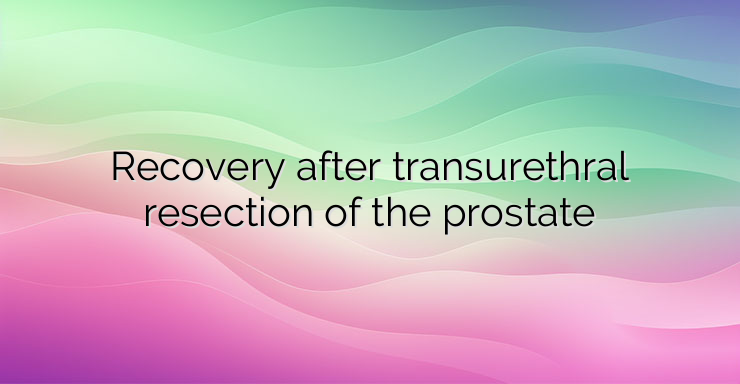Transurethral resection of the prostate (TURP) is a surgery that is used to treat urinary problems caused by an enlarged prostate. It is usually considered an option in men who have moderate to severe urination problems that have not responded to medication. What follows after transurethral resection of the prostate? After transurethral resection of the prostate, the patient may need to spend 1 to 3 days in the hospital recovering before being able to go home. While in the hospital, the patient may be given fluids intravenously, because until he recovers from the anesthesia, he cannot eat or drink water. The patient should not experience severe pain, but may experience some discomfort and bladder spasms (contractions) from the catheter that is left in place because the urethra (the tube that carries urine out of the body) will be swollen and inflamed. Before being discharged from the hospital, the patient is given guidance and advice regarding his recovery. A follow-up check-up should be done a few weeks later after the procedure. How is urination after transurethral resection of the prostate? At first, the patient will not be able to urinate normally because his urethra will be swollen. The catheter used to flush the bladder during surgery will be left in for a while to allow the patient to urinate until the swelling goes down. The day after surgery, the bladder may be flushed through the indwelling catheter to remove any blood clots and other debris. This is usually not painful, but can cause an unpleasant sensation of a full bladder. After the catheter is removed, it should be checked that the patient is able to urinate before being discharged. It is normal for urination to be uncomfortable and difficult for at least a few days after the catheter is removed. If the patient is still unable to urinate after this, the catheter may need to be reinserted. How is recovery from transurethral resection of the prostate at home? It is common for the patient to feel tired and unwell for a week or two after TURP. During the first 3 to 4 weeks, the patient should not lift or move heavy objects (including shopping) or perform strenuous exercise. Once the patient feels able to stand, light exercise such as walking can help maintain circulation and reduce the risk of a blood clot (thrombus) forming in the legs. Drinking plenty of water while the patient recovers can help reduce the risk of getting a urinary tract infection and can help clear blood in the urine. Also, the patient may also be advised to perform pelvic floor exercises to improve bladder control. Any pain can usually be treated with over-the-counter pain relievers,such as paracetamol or ibuprofen. How is the return to normal activities after transurethral resection of the prostate? It usually takes between 3 and 4 weeks for the patient to fully recover from TURP. The surgeon or GP will advise the patient when it is safe to return to normal activities. Work When a patient can return to work will largely depend on their specific activity. For example, a person who works in an office may be able to return to work sooner than a person who does heavy physical work. In most cases, the patient will be advised to take about 3 or 4 weeks off. Having sex It takes about 3 or 4 weeks after surgery before the patient feels comfortable enough to have sex. Blood in the urine After TURP, it is normal to occasionally see a little blood in the urine. About a week or two after surgery, the amount of blood may increase as the prostate scab falls off. Drinking plenty of fluids will help flush blood or small blood clots from the bladder. When should medical attention be sought after transurethral resection of the prostate? When the patient is recovering, they should seek immediate medical attention if: They develop a high fever; He felt severe pain when urinating; Unable to urinate; Notice too much blood in your urine or it’s getting worse; There are blood clots in the urine. These symptoms may be a sign of a problem, such as internal bleeding or a urinary tract infection, that needs to be treated. References: 1. National Health Service (NHS). Transurethral resection of the prostate (TURP) 2. Mayo Clinic. Transurethral resection of the prostate (TURP) 3. Cleveland Clinic. Transurethral resection of the prostateWhen should medical attention be sought after transurethral resection of the prostate? When the patient is recovering, they should seek immediate medical attention if: They develop a high fever; He felt severe pain when urinating; Unable to urinate; Notice too much blood in your urine or it’s getting worse; There are blood clots in the urine. These symptoms may be a sign of a problem, such as internal bleeding or a urinary tract infection, that needs to be treated. References: 1. National Health Service (NHS). Transurethral resection of the prostate (TURP) 2. Mayo Clinic. Transurethral resection of the prostate (TURP) 3. Cleveland Clinic. Transurethral resection of the prostateWhen should medical attention be sought after transurethral resection of the prostate? When the patient is recovering, they should seek immediate medical attention if: They develop a high fever; He felt severe pain when urinating; Unable to urinate; Notice too much blood in your urine or it’s getting worse; There are blood clots in the urine. These symptoms may be a sign of a problem, such as internal bleeding or a urinary tract infection, that needs to be treated. References: 1. National Health Service (NHS). Transurethral resection of the prostate (TURP) 2. Mayo Clinic. Transurethral resection of the prostate (TURP) 3. Cleveland Clinic. Transurethral resection of the prostate


Leave a Reply